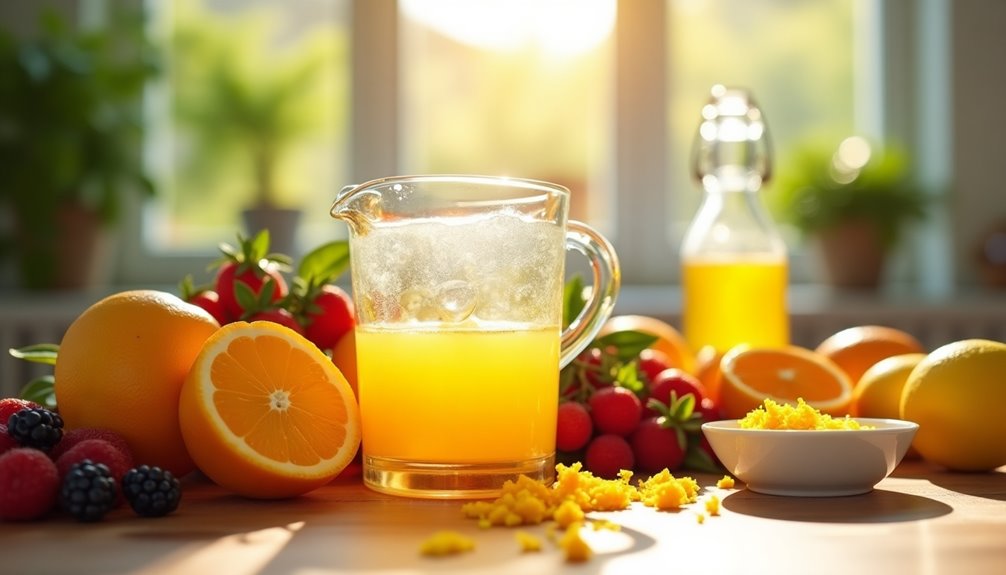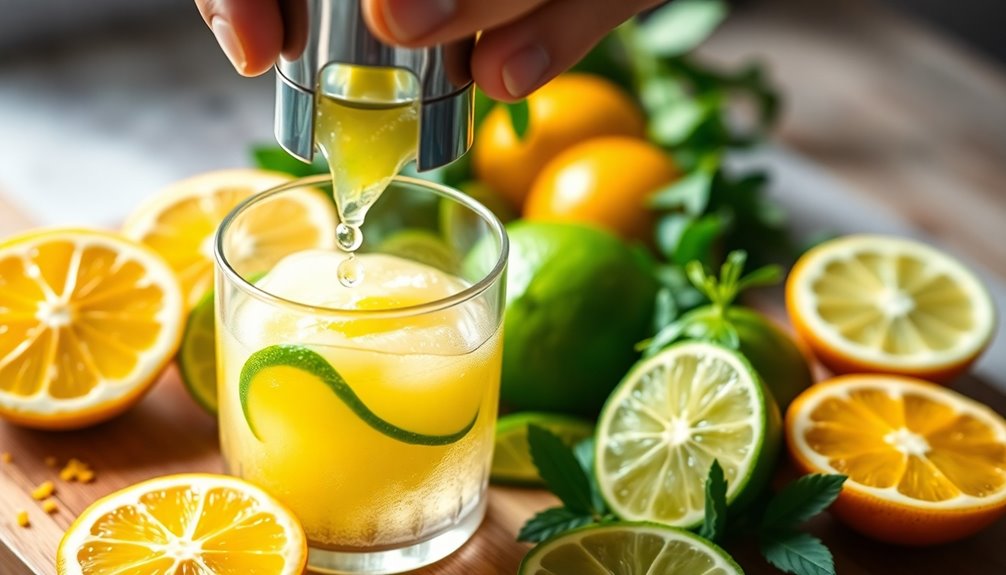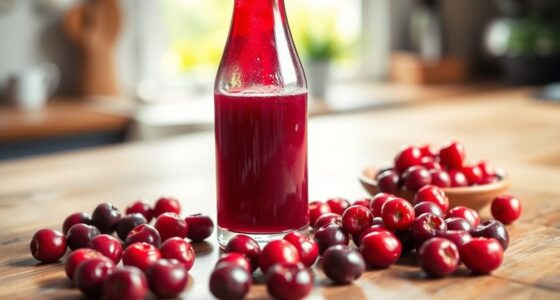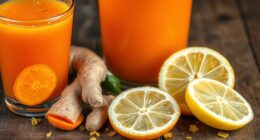To make concentrated juice, start by extracting juice from zesty fruits like oranges and pour it into an air-tight container. Freeze the juice completely, then thaw it when you're ready to enjoy a richer flavor. For harder fruits, boil them first to release their natural sugars, strain the mixture, and freeze the liquid. This method yields different amounts based on the fruit type, so choose wisely. Stick around to discover more tips for flavor enhancement and storage!
Key Takeaways
- Extract juice from fruits like oranges and freeze it in an air-tight container for concentrated flavor.
- Boil harder-to-juice fruits such as berries and pomegranates to release natural sugars before straining.
- Different fruits yield varying amounts of concentrated juice; choose based on desired quantity.
- Freezing and thawing juice enhances its flavor and improves color for better taste experiences.
- Store leftover concentrate in the fridge for up to a week, and use it in cocktails or recipes.

Making concentrated juice can be a rewarding process, especially if you're looking to capture the true essence of your favorite fruits. Whether you're a fan of zesty oranges or sweet strawberries, the steps to create your own juice concentrate are simple and satisfying.
You'll find that using the freezing method for easily juiced fruits like oranges is one of the easiest approaches. Start by extracting the juice and pouring it into an air-tight container. Then, place it in the freezer. Once it's frozen, you can thaw it later, allowing the concentrated flavor to separate from the water.
If you're working with harder-to-juice fruits like berries and pomegranates, you'll need a slightly different technique. Boil the fruit to release its natural sugars and flavors. After boiling, pour the mixture into a juice strainer to separate the solids from the liquid. What you get is a flavorful juice that you can freeze into a frozen block of juice. The freezing process helps to intensify the flavors, giving you a more concentrated result when you're ready to use it.
As you make your juice, it's important to note that the yield can vary significantly. For instance, blueberries usually produce about one cup of concentrated juice, while strawberries yield around two cups. Pomegranates, however, only provide about 1/4 cup of concentrate. This variation can help you decide which fruits to work with based on how much concentrated juice you need.
Each cycle of freezing and melting enhances the flavor and color of your juice concentrate. This means that after thawing your frozen block of juice, you'll notice a richer taste that's perfect for mixing.
When you're ready to enjoy your concentrate, simply take the frozen juice out and let it melt at room temperature. Once it's thawed, you can mix it with water to create a standard fruit juice or use it in various recipes.
Storing your concentrate is easy. Place any leftover juice concentrate in an air-tight container, and you can keep it in the fridge for up to a week. This versatility makes concentrated juice an excellent ingredient for flavoring cocktails or even enhancing recipes like fruit gummies.
Frequently Asked Questions
How Can I Concentrate My Juice at Home?
To concentrate your juice at home, start by freezing freshly squeezed juice in airtight containers for 24 hours.
After that, let it thaw in a strainer to separate the flavorful liquid from the ice.
If you're using harder fruits like berries, boil them briefly after juicing to release more flavor, then strain.
You can repeat the freezing and melting process to intensify the flavor further.
Store your concentrate in the fridge for up to a week.
What Is the Process of Making Juice Concentrate?
To make juice concentrate, you start by extracting juice from fresh fruits.
You can freeze the juice or boil harder fruits to release their flavors. If you freeze, thaw the juice to separate flavorful components from ice.
For boiling, heat the juice, allowing sugars to infuse, then strain out the pulp. You can repeat freezing and melting to boost flavor intensity. After you’ve achieved the desired flavor through boiling and straining, you can take the next step by learning how to start fermenting juice. This process introduces beneficial microbes that enhance the flavor further while also adding a natural effervescence. Be sure to use clean, sterilized equipment to ensure the fermentation is successful and safe.
Store your concentrate in airtight containers in the fridge for up to a week.
What Is Concentrate Juice Made Of?
Concentrate juice is a vibrant symphony of flavors, distilled down to its essence.
It's made from fresh fruit juice, stripped of water, leaving behind a bold burst of taste.
You'll find it crafted from a variety of fruits, each offering its unique sweetness and tang.
Oranges dance into the mix with their zesty notes, while berries bring a deep richness.
Ultimately, you're savoring a concentrated essence, capturing nature's sweetness in every drop.
How to Concentrate Liquid at Home?
To concentrate liquid at home, you can start by freezing your desired juice in airtight containers for about 24 hours.
Once frozen, let the block melt in a strainer to catch the liquid while discarding the ice.
For tougher fruits, boil them after preparing, then strain to separate juice from pulp.
You can repeat this process to intensify the flavor.
Store your concentrated liquid in the fridge for up to a week.
Conclusion
In conclusion, making concentrated juice is simpler than you might think! You just need to choose your favorite fruits, extract the juice, and reduce it to intensify the flavor. There’s a theory that fresh juice loses nutrients quickly, but by concentrating it, you can actually preserve those flavors and vitamins for longer. So, next time you sip on that tangy goodness, remember you’re enjoying a tasty and nutritious treat that you crafted yourself! Additionally, experimenting with different fruit combinations can lead to unique and delicious flavors that are sure to impress your friends and family. If you’re curious about how to blend apple juice with other fruits, consider mixing it with berries or citrus for a refreshing twist. With a little creativity in the kitchen, you can elevate your homemade concentrated juices to a whole new level of deliciousness!
Cindy thoroughly researches juicing trends, techniques, and recipes to provide readers with practical advice and inspiration. Her writing style is accessible, engaging, and designed to make complex concepts easy to understand. Cindy’s dedication to promoting the advantages of juicing shines through her work, empowering readers to make positive changes in their lives through the simple act of juicing.











